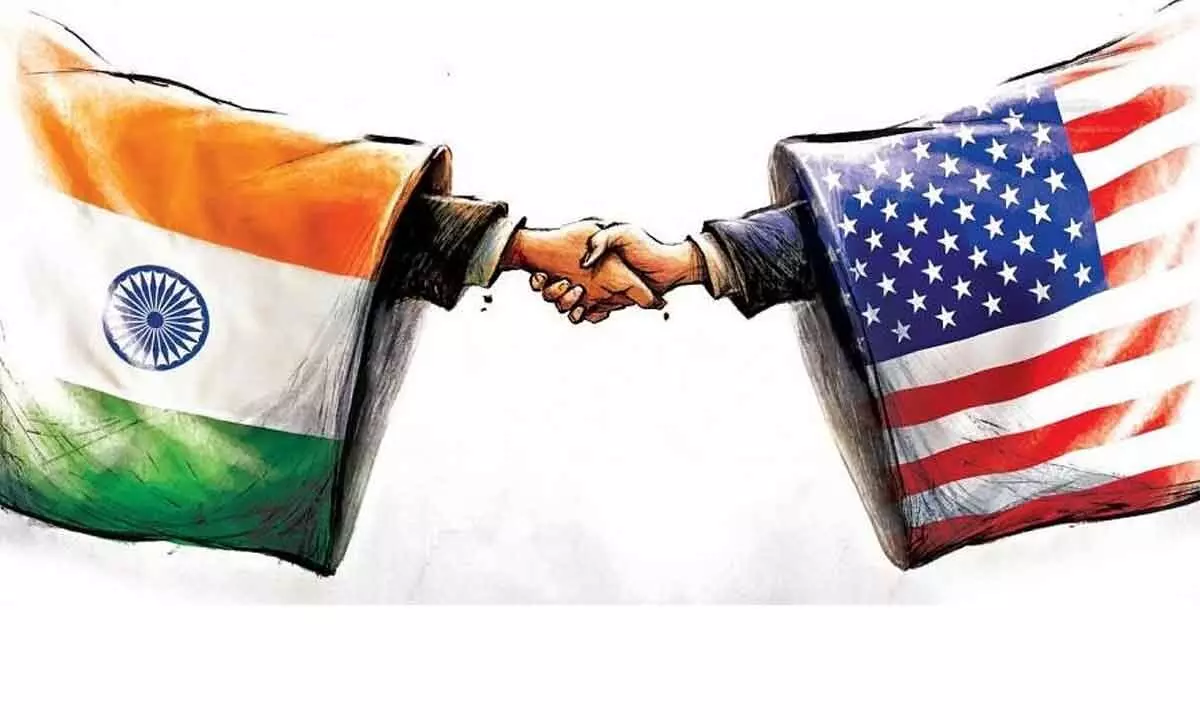India-US Partnership Set for Long Term:

The visit of Prime Minister Narendra Modi to the U.S. has brought the bilateral relationship closer than ever before. The usual volatility in ties between New Delhi and Washington was absent in a meeting that exuded cordiality and warmth. In the past, old Cold War attitudes have tended to cast a shadow over the relationship. Even the apparent bonhomie during the Trump administration was no deterrent to imposing additional levies on steel and aluminium imports from India. Or to withdrawing the benefit of the longstanding Generalised System of Preferences, a scheme providing duty concessions to developing countries. The U.S. and India have been doing a two-step dance with one step forward and two steps back, making their diplomats always a bit wary of each other.
This state visit seems to have ended the hesitancy in bilateral ties. The traditional reluctance of the U.S. to transfer defence technology has finally been let go. The decision to go ahead with joint manufacturing of jet engines by allowing transfer of technology is a pathbreaking development. The positives are not just on one side, as India has also gone ahead to buy predator drones for its armed forces. In this context, it must be noted that India’s heavy reliance on Russia for defence equipment has become a talking point ever since the eruption of the Ukraine conflict. The western coalition waited in vain for India to support its sanctions against Russia . It was then recognised belatedly that the close ties between Moscow and New Delhi partially hinged on the latter’s dependence on Russian armament supplies. Providing access to more sophisticated western equipment may not affect the India-Russia bond but has definitely enhanced the India-U.S. relationship.
On the economic front as well, many of the constant irritants in the bilateral dialogue have been done away with at one stroke. For instance, instead of negotiating endlessly on cutting the punitive duties on steel and aluminium and retaliatory Indian tariffs, both sides resolved the impasse smoothly. A long standing demand of Indian professionals working in the U.S.to ease visa renewal has been made unilaterally. Similarly, the withdrawal of disputes at the World Trade Organisation (WTO) can be considered akin to cutting several Gordian knots.
The fresh element in the relationship between the two countries is the level of collaboration in areas of high technology. The investments announced in the semiconductor space are the culmination of discussions begun two years ago at a meeting of the Quad, the group that comprises India, the U.S., Australia and Japan. It wasthen decided to begin the process of developing a global supply chain using the expertise available in each member country. The initiative was followed by India’s decision to offer incentives to investors in semiconductor processing units. What is most significant is the agreement concluded during the visit envisaging the creation of a resilient supply chain for semiconductors by the two countries.
Cooperation is also proposed in telecom aimed at advancing 5G and 6 G technologies including the Open Radio Access Network (ORAN) systems. But it could well be the proposed collaboration in next frontier of Artificial Intelligence that may define the new partnership between India and the U.S. Given the current buzz over AI and prospects of regulating its growth, a united strategy between two countries which have the largest pool of skilled manpower in this sector, could lead to effective global policymaking.
In the new upgraded relationship between India and the U.S., one tends to forget that it has only now become a partnership between two major economies of the world. This is a far cry from the situation shortly after independence when this country needed foodgrains urgently to feed its people. The U.S. enacted Public Law 480 to enable such supplies to be made against rupee payments. The scenario altered in the sixties when the Green Revolution ushered in high yielding varieties of wheat and rice putting an end to India’s food woes. Subsequently, however , the U.S. viewed this country as being pro-Soviet and relations remained frosty for many decades.
One of the obvious reasons for the greater camaraderie between Washington and Delhi in recent times is the need felt by both sides to provide a counterpoint to China. U.S. firms invested heavily in that country but the uncertainty during the pandemic forced many to opt for a China plus one policy. American strategic interests involving Taiwan have also created a rift that is difficult to bridge. As for India, border clashes with its northern neighbour have increased sharply in recent years, leading to concerns over the depth of economic engagement with Beijing.
Frictions with China are not the only driver for closer ties between India and the U.S. A gentle but decided push is also being given by the Indian diaspora which has made its presence felt both in the Biden administration and in Big Tech. One cannot also dismiss the canny diplomacy of the Modi government which has managed to ensure that India continues to follow an independent foreign policy despite pressures after the Ukraine war. It is following national self interest in buying Russian oil but has also declared its desire for peace rather than conflict. Finally, it is the emergence of India as a major global economic power that ensures the enhanced partnership with the U.S. will be sustained in the long run.


